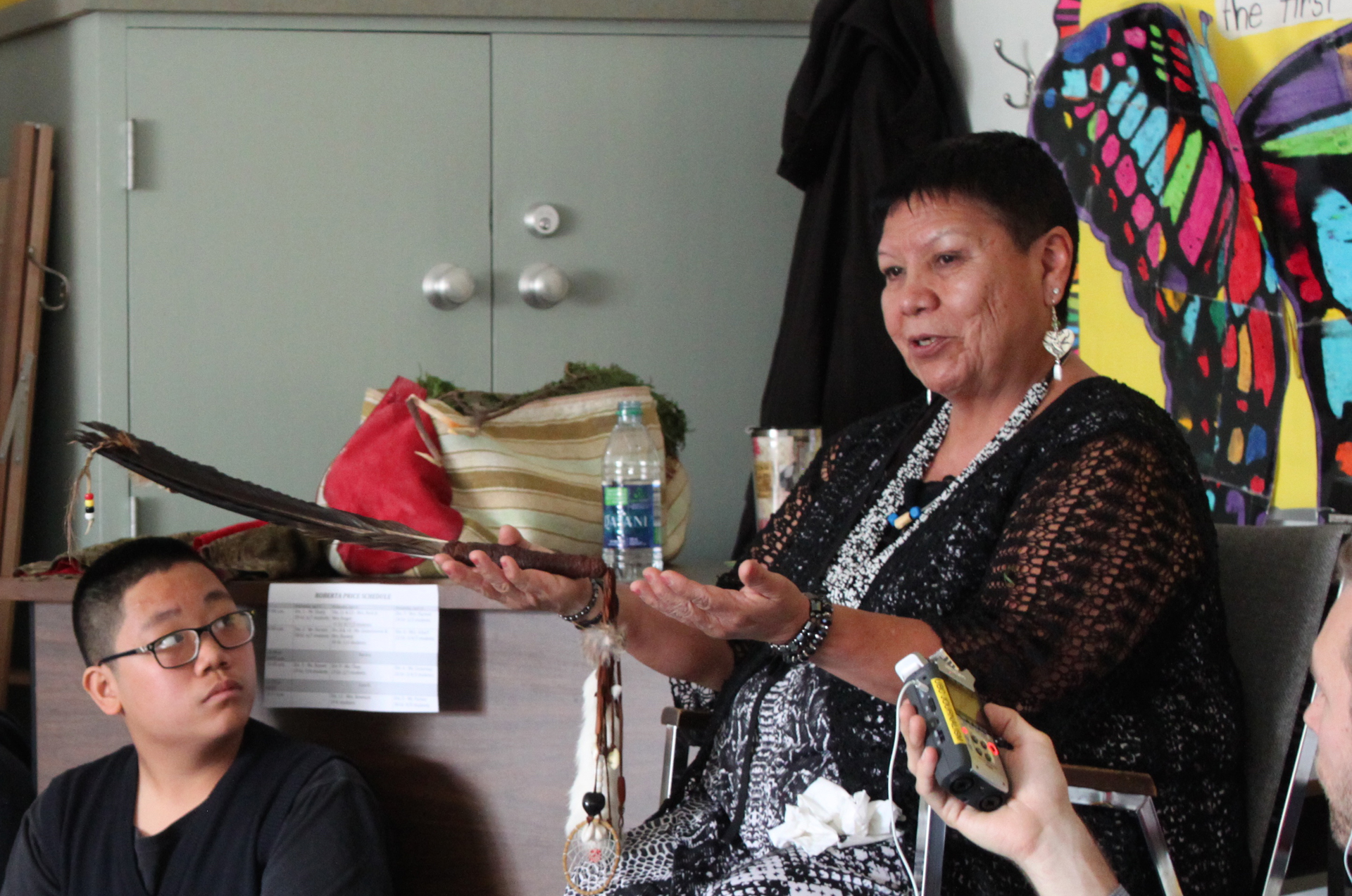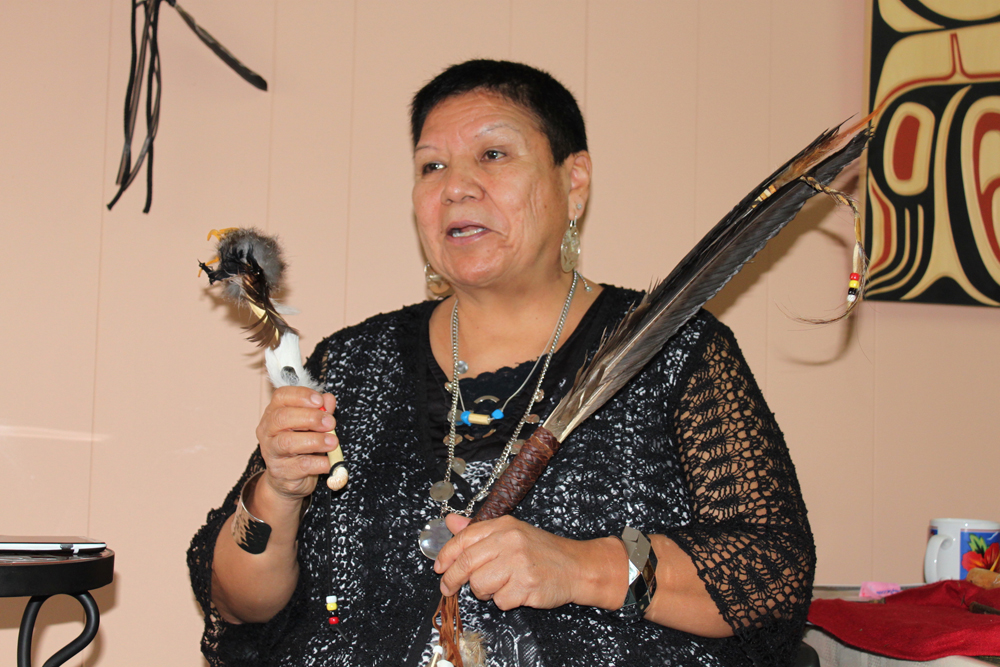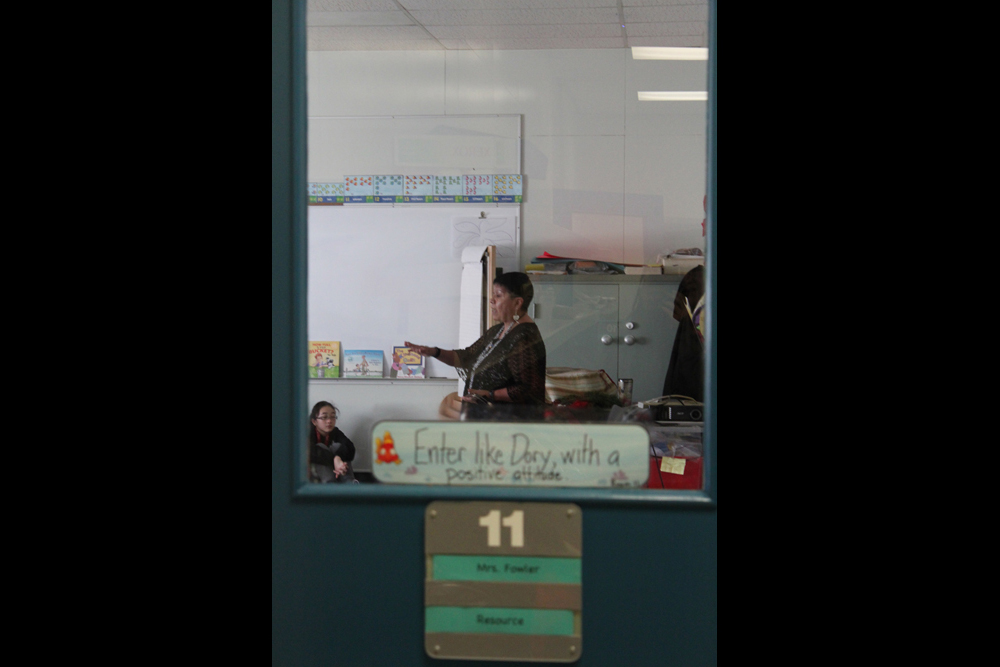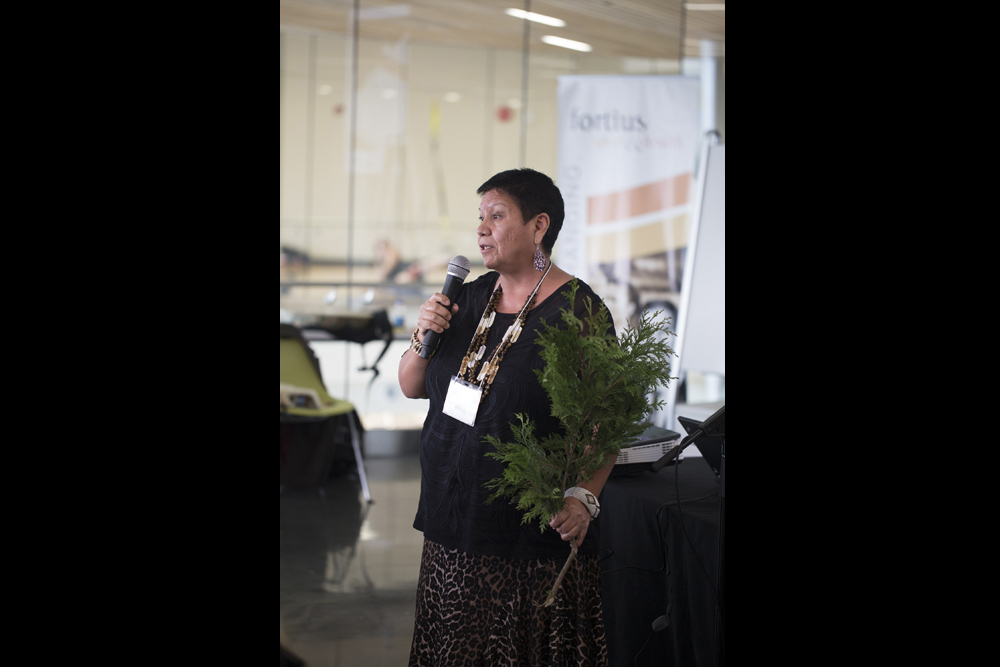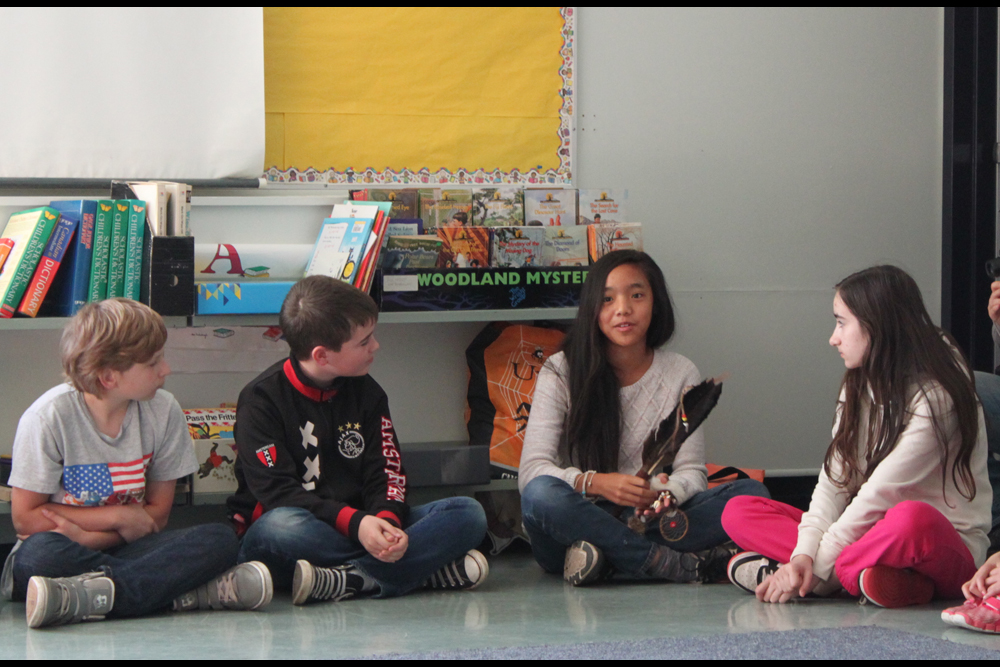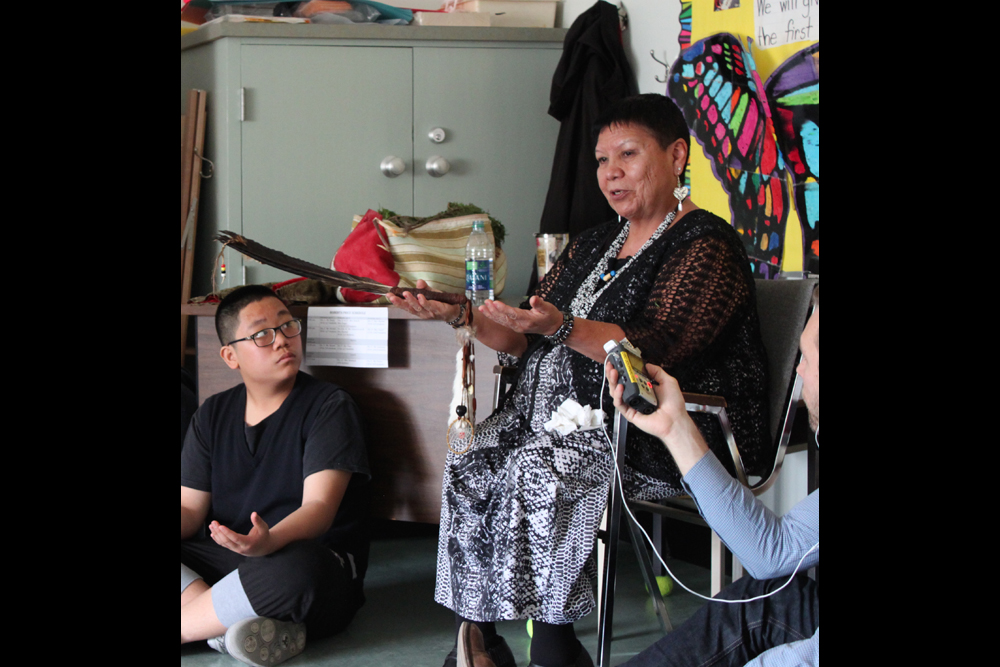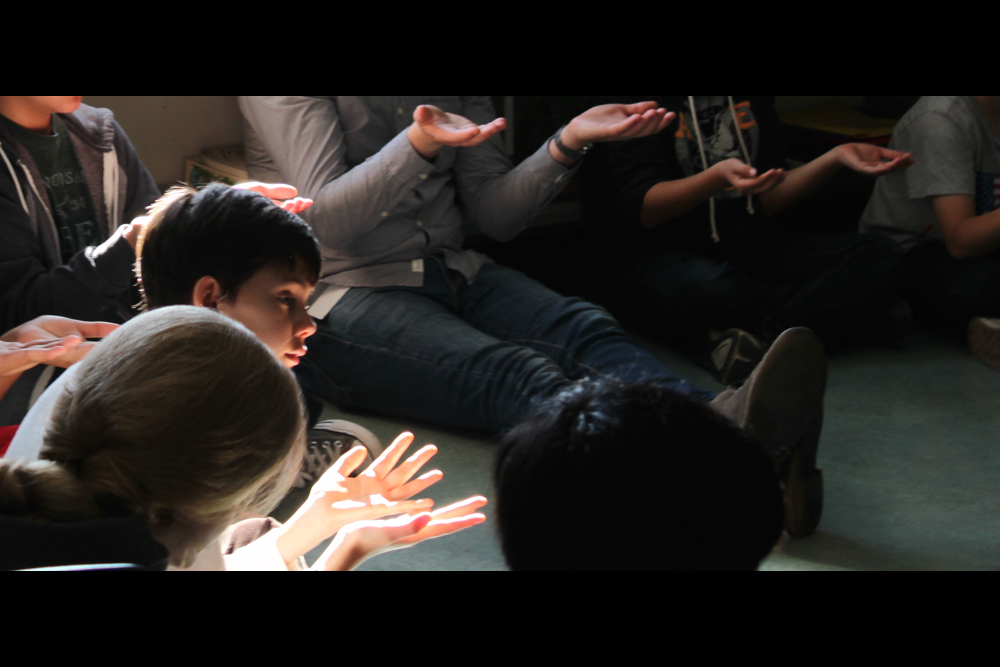17 Apr Vancouver teachers reach out to elders to “indigenize” classrooms
By Tara Maghsoudnia and Meylin Zink Yi
Holding up her eagle feather, Roberta Price opens the conversation at Manoah Steves elementary school with the ceremony of introduction. This is what she does to mark the beginning of her cultural teachings.
“Ceremony is what makes us come together respectfully and politely,” she explains.
The 60-year-old elder from Snuneynuxw and Cowichan First Nations has been sharing her traditional knowledge with students in schools throughout Metro Vancouver for the past 28 years.
“In social studies, aboriginal issues are taught in a very surface kind of way. We are not going into depth in a lot of issues,” Vancouver teacher Alain Raoul said.
Price has been speaking to Raoul’s Social Justice 12 students for the past five years.
“Roberta intertwines her personal stories with aspects of aboriginal culture that are so important.”
Raoul is one of a small number of teachers welcoming Aboriginal elders into Metro Vancouver schools, as a way to introduce Aboriginal content into B.C. curriculum — and educators say such classroom innovations could become more widespread if the Ministry of Education and school boards did their homework on how to support them.
Increasing awareness
Roberta Price’s journey to classroom teaching started with her own two children, when she moved with her family from a small community to Richmond, B.C. in the early 80s. Even though Richmond seemed like a multicultural city to Price, she felt her children were facing discrimination when they identified as Indigenous.
“I saw the way people in the school treated my sons,” Roberta shares. “The mother bear rose up in me, and I thought — I did not get treated well in this system and my sons are not going to be treated like I was.”
As a way to fight what she felt was prejudice toward her children and the lack of support for Aboriginal students, Roberta began volunteering on parent advisory committees in Richmond schools.
Unlike those difficult early days, Price feels educators today are more open and eager to incorporate Aboriginal content in their programs, and younger generations are more welcoming towards First Nations’ role in history.
“When I first went in I was not welcomed by the majority. But, people had to retire, and in comes that generation with newer ideas, with no entrenched beliefs,” says Price.
Raoul was aiming to increase the awareness of his students about Aboriginal cultures and history, and was introduced to Price by a colleague. He believes students often don’t understand they are part of Canada’s colonial history.
“Empathy and compassion are sometimes the hardest to
convey to students who are part of this history, but don’t understand it or — in worse case scenario — have stereotypes.”
Thomas Froh, a social studies teacher at Horizons school in Richmond, has also collaborated with Roberta Price in his classroom. He says Price had a positive impact on his students.
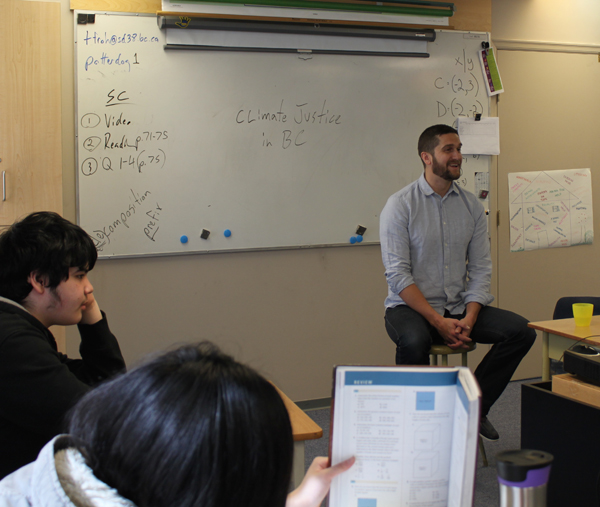
Teacher Thomas Froh speaks to his students about Aboriginal issues.
(Photo Tara Maghsoudnia)
“Roberta has a very calm influence, certainly as a First Nations educator, but really just as a person,” says Froh. “She is actually quite skillful in how to deal with students and their different questions of sensitive nature … she is very open to the conversation.”
Obstacles to teacher-elder collaborations
While some teachers may be keen to work with Aboriginal elders as a way to “indigenize” classrooms, educators agree teacher-elder collaborations remain fraught with difficulties.
The challenges begin, say Froh and Raoul, with the overwhelming amount of curriculum teachers have to cover, which makes it hard to find time to fit elders in.
Aboriginal Education Enhancement Agreement helps teacher-elder collaboration
The Aboriginal Education Enhancement Agreement (EA) is a partnership between the school districts, all local Aboriginal Communities and the Ministry of Education.
This agreement has raised awareness and encouraged teachers and districts to promote Indigenous ways of knowing and the collaboration with elders in classrooms.
One of the goals of the EA is to increase the knowledge and respect for Aboriginal cultures, language and history, which allows for greater understanding for everyone about Aboriginal people.
“There is so much to get through, and we use that as an excuse for not covering certain things.” says Froh.
Another problem, according to Susan Tatoosh, executive director of Aboriginal Friendship Centre, is some teachers and principals avoid including Aboriginal elders’ knowledge in the classrooms because of the complexities involved in the process.
“It’s easy to brush it aside and put it on the back burner,” says Tatoosh. “Dedicated teachers who recognize the importance of it will continue to reach out,” she adds.
Tatoosh says finding an elder, or financial compensation for elders’ time, are often troublesome issues.
The Vancouver School Board (VSB) and the Aboriginal Friendship Centre have a contract to connect teachers with elders when it’s requested, but Tatoosh suggests teachers often aren’t aware of that resource.
Funding to pay elders also appears to be limited, says Tatoosh, who recalls that VSB has had a budget assigned for elders’ honorarium, but that only lasted one year.
As a result, teachers such as Alain Raoul wind up searching for Elders through personal connections. Raoul fundraises towards the cost of bringing Price into the classroom, rather than asking for help from the school board.
By contrast, Thomas Froh successfully applied for funding for elders’ initiatives under three different administrations in Richmond. “When it comes to educating about First Nations, there are a lot of resources out there, from what I can tell,” he shares.
The teaching approaches used by Aboriginal elders may also present difficulties.
Moniques Giard, Aboriginal counselor at the Richmond School District, points out many Aboriginal people are still healing from being forcibly removed from their families and cultures. As a consequence, it may be challenging for teachers to find elders who can pass on their knowledge in a positive, non-judgmental way.
Roberta recalls that, in the beginning, she went into the classrooms feeling anger and pain. “I just planted myself to make a difference for my boys,” she says. What she received in return brought her to a full circle of healing.
“Now I feel like a treasure, because teachers and children are so excited for me to be able to come into their classes,” says Price.
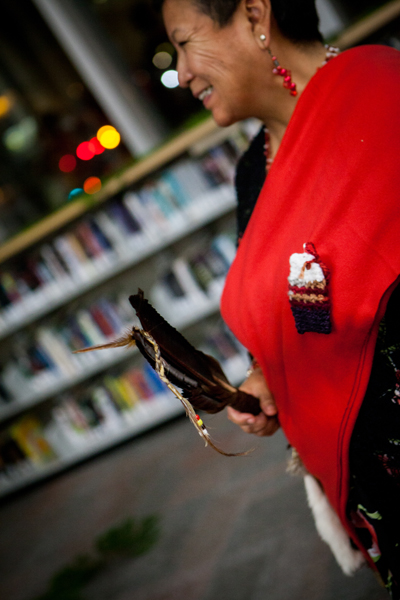
Roberta Price, in part, began volunteering in the school system in response to a lack of support for Aboriginal students. (Photo Burnaby School district)



